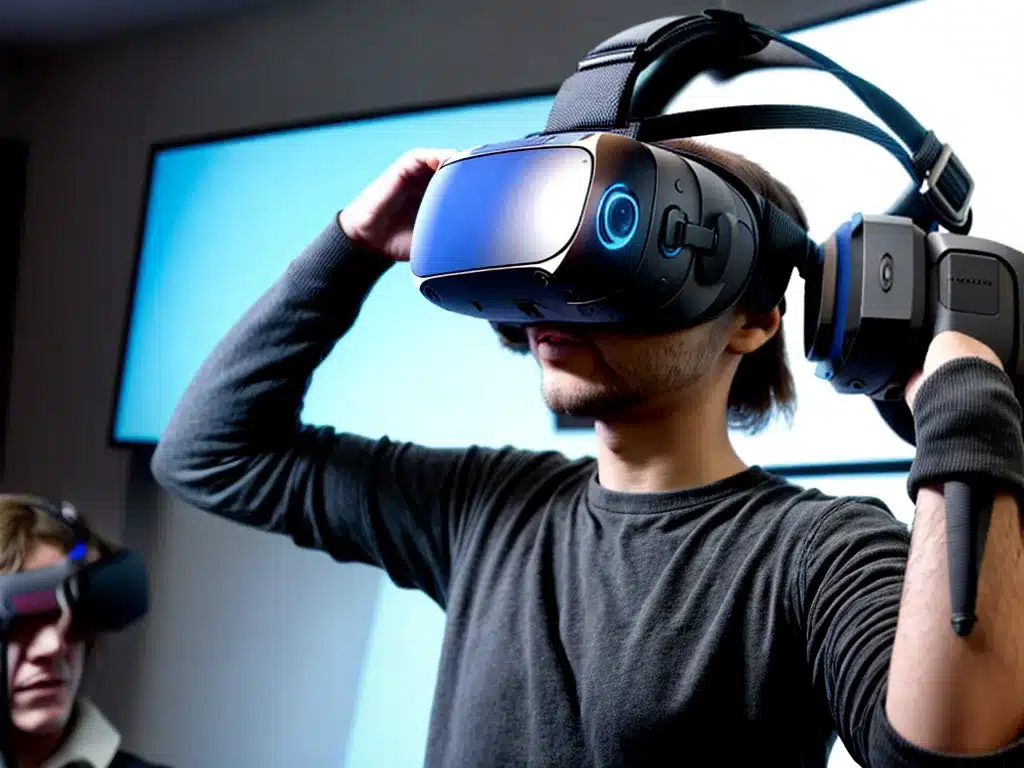
I have been interested in virtual reality (VR) technology for many years. As an avid gamer and someone fascinated by cutting edge technology, I try to stay on top of the latest developments in the VR space. In particular, I am excited about the graphical capabilities of the next generation of VR headsets coming to market. In this article, I will provide an in-depth look at how these new VR headsets are pushing graphics quality to new heights.
Higher Resolution Displays
One of the most impactful upgrades in the latest VR headsets is the move to higher resolution displays. The current consumer VR headsets like the Oculus Quest 2 and HTC Vive Pro 2 feature displays with 1832×1920 pixels per eye. However, the next generation headsets will make the jump to 2160×2160 or higher pixel counts per eye.
For example, the Pimax Reality 12K QLED VR headset uses two 6K mini-LED displays to achieve a combined resolution of 4320×2160 per eye. This is a significant upgrade from current headsets and will allow for crisp, clear visuals with high pixel density. The higher resolution reduces the screen door effect caused by visible gaps between pixels. It also enables much sharper and more detailed image quality that further enhances the sense of presence in VR.
Key Benefits of Higher Resolution VR Displays:
- Sharper, more detailed visuals
- Reduced screen door effect
- Enhanced sense of immersion
Higher resolution displays are one of the most impactful upgrades coming to next generation VR headsets that will greatly improve graphical quality. The jump to 4K per eye visuals will make virtual environments and objects appear strikingly realistic.
Expanded Field of View
In addition to improved resolution, the field of view (FOV) is also being expanded in next-gen VR headsets. FOV refers to the horizontal and vertical angular extent of the visible VR environment. Most current consumer headsets have a FOV of about 100 degrees. However, human natural vision is closer to 180 degrees horizontally.
Upcoming headsets like the Pimax Reality 12K QLED aim for a FOV of 115 degrees or more. This expanded field of view increases peripheral vision within the virtual environment. With a wider FOV, users can take in more of the virtual world without needing to turn their head as much. It makes for a more natural, immersive experience.
Key Benefits of Wider FOV:
- Increased peripheral vision
- More natural, human-like FOV
- Heightened sense of immersion in VR worlds
The combination of higher display resolution and expanded field of view in next-gen headsets will dramatically improve graphical capabilities. Users will feel an enhanced sense of presence and realism as they explore expansive virtual environments.
Foveated Rendering and Eye Tracking
To push graphics further, some VR headsets will also incorporate foveated rendering and eye tracking technologies. Foveated rendering involves dynamically adjusting the image quality in the user’s field of view. The area they are directly looking at is rendered in full resolution, while the peripheral regions are rendered at lower resolution to save on processing power.
Eye tracking capabilities enable this by continuously monitoring where the user’s eyes are focused. The headset and graphics card then only need to allocate full processing power to the focal area rather than the entire field of view.
Benefits of foveated rendering with eye tracking:
- Reduces GPU processing requirements
- Enables higher overall image quality
- More efficient performance
Foveated rendering maximizes graphical quality where it matters most – the user’s focal point. Next generation headsets will leverage this to push VR graphics even further.
New Display Technologies
Cutting edge display technologies are also coming to next-gen VR headsets. For example, the Varjo Aero utilizes mini-LED and micro-OLED displays. Mini-LED has thousands of tiny LEDs for striking brightness and deep blacks. Micro-OLED delivers ultra-high resolution in a compact form factor built directly into the VR lenses.
Other headsets may incorporate emerging displays like OLED-on-silicon. This uses silicon transistors in the OLED substrate for higher pixel density. There are also developments in integrating displays directly into prescription lens inserts for clearer visuals without glasses inside VR headsets.
Key new display technologies:
- Mini-LED and Micro-OLED
- OLED-on-silicon
- Displays built into prescription lenses
These displays will provide key improvements in factors like resolution, brightness, and contrast – all leading to best-in-class graphical capabilities.
Powerful New GPUs
Driving the graphically intensive displays and experiences in next generation VR headsets will require substantial GPU horsepower. New GPU architectures like NVIDIA’s Ada Lovelace and AMD’s RDNA 3 will offer considerable performance gains over current graphics cards.
Key GPU improvements:
- Higher processing speeds
- More CUDA cores
- Added ray tracing capabilities
- Enhanced AI rendering techniques
Combined with foveated rendering, these powerful new GPUs will help push VR graphics and realism to new heights. Their increased speed and capabilities will be able to drive resource-heavy visuals like high resolution textures and complex lighting.
Conclusion
The next generation of VR headsets arriving in the coming years will feature major advancements to greatly enhance graphical quality and capabilities. With higher resolution displays, expanded field of view, innovative rendering techniques like foveated rendering, new display technologies, and faster GPUs, VR is poised to become more realistic and immersive than ever before. As both VR hardware and software matures, we will see visual quality take a major leap forward and enable engrossing new virtual worlds. These new headsets will push the limits of what is graphically possible in current consumer VR devices. It is an exciting time for VR technology and the experiences it will enable as graphics advance to the next level.












